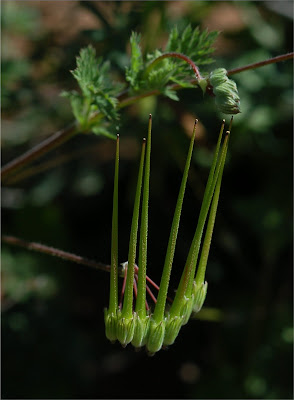couldn't resist returning to my old stomping grounds. The news media were predicting the biggest wildflower display in years, and my gut was telling me the same thing. Southern California, like South Africa is a rugged, dry land, with hot rainless summers. Rain falls in the winter, and when adequate and consistent supports a rich and varied array of spring wildflowers. One never can be sure exactly when the peak display will be, so making flight reservations from Florida involves some educated guessing. Having been out before in March, I choose the last weekend of March and early April for the trip. I wasn't disappointed.
| California poppies (Eschscholtiz californica, Papaveraceae) were at peak bloom, but on this day a strong cold wind prevented them from opening fully. |
Arriving in LA in the morning, my wife and I grabbed our rental car and headed north. We stopped briefly to pick up our friend Chung-Shu who had flown in from New Jersey the night before, and then made a bee-line for the Antelope Valley State Poppy Preserve. Though having seen California poppies many times before (see For the love of poppies), I had not seen this preserve and wanted to check it out. Chung-Shu had become an avid bird-watcher after retirement, and hearing about our trip, decided he'd like to see what all the hub-bub about wildflowers was about.
He was not disappointed, and may have picked up another hobby as he turned his birding camera toward the brilliant blooms. Poppies were out in force, but a strong cold wind that day was shaking them violently, preventing them from opening fully and making photography a challenge.
| "Goldfields," Lasthenia californica (Asteraceae) paints the valleys and hillsides of the Antelope Valley a bright yellow. |
| The compound flowers of Lasthenia feature a puffy mound of disk flowers in the center. |
Adding a subtler touch of orange or yellow was Amsinckia tessellata, whose small flowers appear over time on coiled, fiddlehead- like inflorescences.
 |
| Amsinckia tesselata (Boraginaceae) is locally abundant, though the small flowers are individually inconspicuous. |
Yellow and orange were dominant, but not the only colors present. The brilliant blue Phacelia tanacetifolia flooded some pockets along the hillsides, and the tiny Lupinus bicolor seemed to be everywhere. The purple heads of Dichelostemma capitatum could be seen lifted high above the fields of Lasthenia, and the tiny cranesbill, Erodium cicucutarium (Geraniaceae) was everywhere.
| The yellow-orange flowers of Amsinckia tesselata open in sequence from a coiled inflorescence. |
 |
| Phacelia tanacetifolia (Boraginaceae), or Lacey Phacelia is abundant in small patches. Photo by Chung-Shu Yang. |
| The flowers of Phacelia are in tight coils, and are in the same family as Amsinckia. |
| Lupinus bicolor is one of the smallest lupines, and easily overlooked. |
| Dichelostoma capitatum (Asparagaceae) waves its purple heads above a field of Lasthenia. |
| The flowers of Dichelostoma capitatum superficially resemble crocuses, but are more closely related to Asparagus |
 |
| Like other members of the Geranium family, Erodium has peculiar, long, pointed fruits, that when dry curl and twist to help dril the seed into the soil. |
| The small flowers of Erodium cicutarium would be our companions throughout southern California. |
| The Arthur B.Ripley Desert Woodland State Park contains some fine stands of Joshua tree and juniper. |
 |
| Salvia columbariae blooming at the Ripley Park. |
| Lupinus longiflora. |
| Oenothera deltoides. A tiny specimen of Lupinus bicolor is just to the left of center. |
But the biggest surprise was yet to come. As we moved further west toward the mountains, we entered another region of spectacular wildflowers. We found another lupine, Lupinus longifolia, and the white evening primrose, Oenothera deltoides, growing along the roadside, and then a spectacular sight. Finally we found that the hills at the west end of Antelope Valley were painted with another brilliant shade of yellow, not from goldfields or California poppy, but from another member of the Asteraceae, Coreopsis bigelovii. Perhaps I should have subtitled this segment "Fifty shades of yellow."
With our expectations more than met, we happily started across the mountains toward the Pacific Ocean.
No comments:
Post a Comment
Note: Only a member of this blog may post a comment.